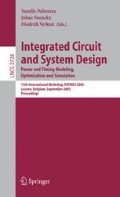Abstract
The energy efficiency of a 0.25 μm general-purpose FIR filter design, based on two-phase clocking, versus a functionally equivalent benchmark, based on one-phase clocking, is demonstrated by means of measurements and transistor level simulations. Architectural improvements enable already a 20% energy savings of the two-phase clocking implementation. Yet, for the first time, the limitations imposed by the supply voltage (< 2.1 V) and the operating frequency (< 10 MHz) on the actual energy efficiency of this low-power strategy are investigated. Transistor level re-design is undertaken: a new slew-insensitive latch is presented and replaced inside the two-phase implementation. Spectre simulations point out the final 30% savings.
Access this chapter
Tax calculation will be finalised at checkout
Purchases are for personal use only
Preview
Unable to display preview. Download preview PDF.
References
Mosch, P., et al.: A 660-μW 50-Mops 1-V DSP for a Hearing Aid Chip Set. IEEE Journal of Solid-State Circuits 35, 1705–1712 (2000)
Arm, C., Masgonty, J., Piguet, C.: Double-Latch Clocking Scheme for Low-Power I.P. Cores. In: Soudris, D.J., Pirsch, P., Barke, E. (eds.) PATMOS 2000. LNCS, vol. 1918, pp. 217–224. Springer, Heidelberg (2000)
Zyuban, V.: Optimization of Scannable Latches for Low Energy. IEEE Trans. on VLSI 11, 778–788 (2003)
Ching, L., Ling, O.: Low-power and low-voltage D-latch. IEE Electronics Letters 34, 641–642 (1998)
Zyuban, V., Meltzer, D.: Clocking Strategies and Scannable Latches for Low Power Applications. In: ISLPED, pp. 346–351 (2001)
Erdogan, A.T., Zwyssig, E., Arslan, T.: Architectural trade-offs in the design of low power FIR filtering cores. IEE Proc. Circ. Dev. Syst. 151, 10–17 (2004)
Wassner, J., et al.: Waveform Coding for Low-Power Digital Filtering of Speech Data. IEEE Trans. on Signal Processing 51, 1656–1661 (2003)
Nose, K., Sakurai, T.: Analysis and Future Trend of Short-Circuit Power. IEEE Trans. on CAD of IC and Systems 19, 1023–1030 (2000)
Author information
Authors and Affiliations
Editor information
Editors and Affiliations
Rights and permissions
Copyright information
© 2005 Springer-Verlag Berlin Heidelberg
About this paper
Cite this paper
Carbognani, F., Bürgin, F., Felber, N., Kaeslin, H., Fichtner, W. (2005). Two-Phase Clocking and a New Latch Design for Low-Power Portable Applications. In: Paliouras, V., Vounckx, J., Verkest, D. (eds) Integrated Circuit and System Design. Power and Timing Modeling, Optimization and Simulation. PATMOS 2005. Lecture Notes in Computer Science, vol 3728. Springer, Berlin, Heidelberg. https://doi.org/10.1007/11556930_46
Download citation
DOI: https://doi.org/10.1007/11556930_46
Publisher Name: Springer, Berlin, Heidelberg
Print ISBN: 978-3-540-29013-1
Online ISBN: 978-3-540-32080-7
eBook Packages: Computer ScienceComputer Science (R0)

